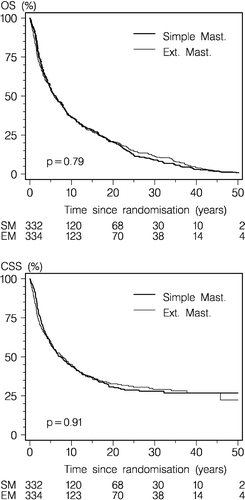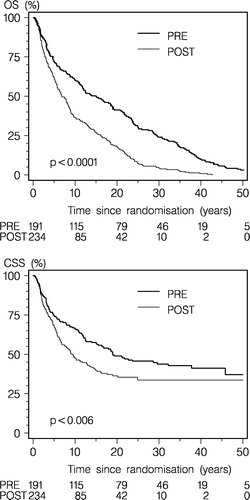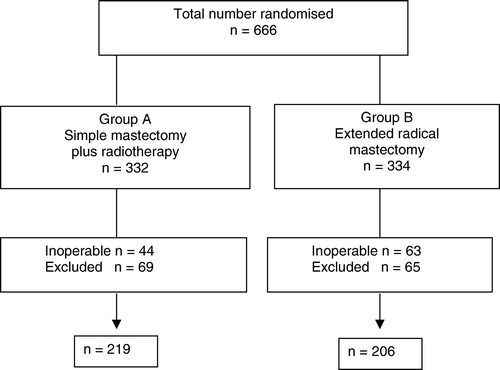Abstract
From November 1951 to December 1957, 666 consecutive patients with untreated primary breast cancer admitted to the Radium Center in Copenhagen were randomised before their operability was evaluated into two groups, simple mastectomy with postoperative radiotherapy or extended radical mastectomy. Following physical examination 241 of the patients were excluded, primarily due to tumours deemed inoperable due to clinical criteria (n =107) and due to poor general condition (n =69). Twenty-five years results of disease-free free survival and fifty years results of survival are presented, showing no difference between the two groups. Patients with clinical stage I did significantly better than patients with stage II-III tumours. Patients with grade I tumours had a better survival than patients with grade II-III. The breast cancer associated mortality was lower in premenopausal patients compared to postmenopausal patients. An excess mortality due to breast cancer was evident up to 20–25 years following the primary diagnosis.
The routine use of radical mastectomy, i.e. removal of the breast and resection of axillary and infraclavicular lymph nodes, in operable breast cancer was introduced by Halsted in 1894 Citation[1]. Up to the mid of the previous century this was a standard procedure in primary breast cancer, in the later part of the period in selected cases supplemented by pre-or postoperative radiotherapy. The background for this approach was the assumption of breast cancer being a local disease confirmed to the breast for a long period of time followed by gradual spread to regional nodes and vessels.
However it became evident that primary breast cancer was associated with frequent loco-regional recurrence leaving the Halsted's procedure insufficient.
This lead to different therapeutic approaches, either an extension of the Halsted's operation to include also dissection of the supraclavicular and parasternal nodes, i.e. extended radical mastectomy Citation[2], Citation[3] or less radical surgical procedures such as simple mastectomy Citation[4] or even, in small tumours, merely excision of the tumour Citation[5] supplemented by post operative radiotherapy. Non-randomised data presented by McWhirter Citation[4] indicated that simple mastectomy followed by radiotherapy might be as safe as radical mastectomy.
This hypothesis was tested in the present study. Patients with primary breast cancer were randomly allocated to one of the two procedures, simple mastectomy followed by radiotherapy or extended radical mastectomy. This presentation is an update of previous publications from the study Citation[5], Citation[7].
Material and methods
Patients
All women domiciled in Copenhagen with primary breast cancer and admitted to the Radium Center in Copenhagen were considered eligible for the trial. These patients were given a consecutive numbering of their case records. The numbers were given prior to the first examination of the patient and decided the randomisation. Patients given even numbers were offered extended radical mastectomy and patients given odd numbers were offered simple mastectomy followed by radiotherapy. According to the routine procedure by that time patients were not informed about the random allocation to either of the approaches.
The clinical examination included clinical staging and evaluation of operability according to Haagensen and Stout Citation[8]. Accordingly criteria of inoperability included extensive oedema or satellite nodules of the skin over the breast, inflammatory cancer, parasternal or supraclavicular or distant metastases, oedema of the arm or at least 2 of the following criteria: Ulceration of the skin or oedema of more than 1/3 of the skin over the breast, fixation of tumour to the chest wall, axillary nodes measuring 2.5cm or more or fixation of axillary nodes to skin or the deep structures of the axilla.
Patients, considered being inoperable or who refused to have the operation, were in both groups offered irradiation and/or hormonal therapy, which included ovarian ablation by radiotherapy in premenopausal and estrogens in postmenopausal women.
Treatments
Simple mastectomy followed by radiotherapy
The surgery consisted of simple mastectomy only and was carried out at the Bispebjerg Hospital, Department A. The amount of skin removed was limited in order to permit primary closure of the wound without the use of skin grafting. Only when the tumour was fixed to the pectoral fascia was this fascia removed together with part of the pectoral muscle. No axillary dissection was carried out.
Postoperative irradiation was started as soon as the wound had healed, usually about 2 weeks after the operation. The irradiation was given to the fields used by McWhirter Citation[4], an anterior and a posterior field to the axilla and supraclavicular region (fields I and II), and two opposing fields tangential to the chest wall, including the internal mammary chain on the operated side (fields III and IV). The border between fields I and III-IV was a line along the upper edge of the 2. costal cartilage with the arm abducted about 90 degrees and the head turned to the opposite side. The anterior field measured 24×12 cm and reached the mid-line with a small lead shield for larynx. The posterior field measured 24×10 cm and had an oblique course, covering both the axilla and the supraclavicular region. The two tangential fields, 10×15 cm, had a medial limit along the opposite sternal border and a lateral limit along the mid-axillary line. Bolus bags were used for all fields. From 1951 to August 1953, 180 kV x-rays were used for treatment of the chest wall and the lymph node fields. After August 1953, 400 kV was used for the anterior and posterior lymph node fields; and from October 1956, 250 kV for the chest wall fields. All fields were treated 6 days per week for 3 weeks (18 treatment days), maximum tissue dose was originally about 45 Gy, but, because of severe skin toxicity, was later reduced to about 42 Gy. The central dose varied with the distance between the fields, the mid-axillary dose was in most cases 38–40 Gy.
Extended radical mastectomy
The surgery was carried out at the Rigshospitalet, Surgical Department C, and included radical mastectomy with dissection of the lymph nodes in the axilla, infra- and supraclavicular regions and the 2. to 4. intercostal space according to the Dahl-Iversen method Citation[2]. No postoperative radiotherapy was administered.
Pathology
Histopathology included verification of the diagnosis of invasive breast carcinoma. All but one of the tumours from patients entering the study from November 1, 1951 to December 31, 1956 have been histologically graded retrospectively by now retired Professor Torben Schiødt, Department of Pathology, Rigshospitalet, according to Bloom and Richardson Citation[9].
Follow up
Clinical examination was repeated every 3 months during the first year, then every 6 months during the second through the tenth year, and thereafter annually for up to 25 years. A complete follow-up until September 2007 on vital status was obtained through linkage to the Danish Civil Registration System.
For all patients who died, information about the cause of death was obtained by linkage to the Death Certificate Registry. Breast cancer was the cause of death if verified by autopsy or if recurrent disease had been diagnosed prior to death.
Statistical analyses
Overall survival (OS) was calculated as time from randomisation until death, irrespective of cause. The cause-specific survival (CSS) was defined as the interval from date of randomisation to the date of death from breast cancer or to the last follow-up date (for censoring purposis). The duration of disease-free survival (DFS) was defined as time from randomisation to loco-regional recurrence, distant metastases, contralateral breast cancer, other malignant disease or intercurrent death, whichever occurred first. Survival probability was estimated by the Kaplan-Meier method. DFS, CSS and OS were analysed unadjusted and the two treatment regimens were compared using the log-rank test.
Results
From November 1951 to December 1957, 666 patients were randomised to either of the two options, hereof 332 to simple mastectomy plus postoperative irradiation (group A) and 334 to extended radical mastectomy (group B) (). A total of 107 patients (44 in group A and 63 in group B) had tumours that were inoperable according to the Haagensen criteria Citation[8]. This subgroup of patients had a poor prognosis. At 5 years 13% were alive, at 10 years 5%, at 15 years 4% and at 20 years all had died.
In addition 69 and 65 patients respectively in groups A and B were excluded for reasons shown in . For the majority of patients other reasons were the patients’ preference to have surgery in her local hospital rather than in the two hospitals in charge of the surgical procedures in the study (see methods).
Table I. Exclusion among patients operable among to the Haagensen Citation[7] criteria.
Thus 219 patients were eligible for simple mastectomy (followed by radiotherapy) and 206 patients for extended radical mastectomy. However, in the latter group, at time of operation, 2 refused the extended radical mastectomy and 8 were in too poor condition for surgery. In addition 15 patients proved technically inoperable during the surgery. These 25 patients all had simple mastectomy followed by radiotherapy. However, in the subsequent analyses they are kept in group B.
The two groups of randomised patients had similar characteristics as concerns age, menopausal status, and clinical axillary nodal status ().
Table II. Characteristics of the 666 randomised patients.
presents data from the total group of randomised patients (n = 666), overall survival (OS) up to 50 years and cause-specific survival (CSS) up to 50 years following the primary diagnosis. As appears no differences between the two groups are apparent. gives the data for the group of patients allocated to simple mastectomy followed by radiotherapy (n = 219) or to extended radical mastectomy (n = 206), as concerns OS and CSS up to 50 years after the primary diagnosis, and disease-free survival (RFS), up to 25 years. No differences are observed as concerns OS, CSS, and RFS. It is further apparent from and that the CSS curves reach a plateau at about 20–25 years following the primary surgery.
Figure 2. Kaplan-Meier estimates of overall survival (OS) (top panel) and cause-specific survival (CSS) (bottom panel), comparing treatment regimes for all 666 patients randomised to simple mastectomy followed by radiotherapy (SM) versus extended radical mastectomy (RM).

Figure 3. Kaplan-Meier estimates of overall survival (OS) (top panel), cause-specific survival (CSS) (centre panel) and disease-free survival (DFS) (bottom panel), comparing treatment regimes for 425 patients, allocated to simple mastectomy followed by radiotherapy (SM) versus extended radical mastectomy (RM).

A previous publication Citation[6] presented the rate of loco-regional and distant metastases according to time of follow-up up to 10 years among 425 patients eligible for one of the two treatment options. Distant metastases were equally distributed in the two groups (47% in group A compared to 46% in group B at 10 years), whereas loco-regional recurrences remained less frequent in group A, 18% versus 21% at 5 years and 22% versus 27% at 10 years. Further follow-up data on the distribution of recurrences have not been registered.
Among the total group of randomised patients (n = 666) 68 second malignancies were registered, hereof 37 in group A and 31 in group B.
At the time of this analysis all but 6 of the 666 patients have died. Cause of death is presented in .
Table III. Cause of death among the 666 randomised patients.
The OS and CSS according to menopausal status () show a superior prognosis in the premenopausal group.
Figure 4. Kaplan-Meier estimates of overall survival (OS) (top panel) and cause-specific survival (CSS) (bottom panel), according to menopausal status for 425 patients allocated to simple mastectomy followed by radiotherapy or to extended radical mastectomy.

In the previous analysis Citation[7] with observations up to 25 years following the primary diagnosis patients with stage I tumours did significantly better than stage II + III tumours, as did patients with grade I tumours compared to grade II and III tumours.
Morbidity in terms of lymphoedema was evaluated one year following the primary surgical procedure. Increase of the extension of the forearm or upper arm of 2 cm ore more was observed in 4% of the patients in group A compared to 12% in group B.
Discussion
To our knowledge this is the first randomised trial of different local approaches in the treatment of primary breast cancer.
Among the 666 originally randomised patients only 64% (425) were allocated to one of the 2 treatment arms of the study. However this could be ascribed to the nature of the randomisation procedure and is unlikely to introduce a bias in the interpretation of the data. Thus, on admission to the study centre, all patients were considered potentially eligible and were given consecutive numbers of their case records; odd number to be allocated to group A and even numbers to group B. Not until the subsequent physical examination did it become apparent that a large proportion of the patients had to be excluded for reasons described above. In addition, the number of patients excluded and the reasons to be excluded were similar in the two groups.
The data demonstrate that the mutilating extended radical mastectomy can be safely substituted by simple mastectomy with addition of radiotherapy against the chest wall and regional nodes. The similar outcome in terms of survival with the very different loco-regional treatment approaches can be ascribed to the fact that the prognosis is primarily determined by existence of distant micrometastatic disease. This also agrees with data from an overview of four randomised trials comparing radical mastectomy against simple mastectomy followed be radiotherapy Citation[10] and an overview prepared by The Early Breast Cancer Trialist's Collaborative Group of the effect of different local treatment procedures in primary breast cancer Citation[11]. It is also remarkable that the simple mastectomy plus irradiation was associated with a similar or even lower risk of loco-regional recurrence and with a lower risk of morbidity in terms of lymphoedema.
In agreement with subsequent studies from DBCG Citation[12] the present study demonstrated the prognostic implications of the stage and the grade of the primary tumour. The prognosis was superior in the premenopausal patients compared to the postmenopausal. In the subsequent DBCG-study Citation[12] we observed a similar trend. However, when the sample size allowed a more detailed analysis of the premenopausal subgroup, it was apparent that patients less than 35 years at diagnosis did significantly inferior to the older, yet premenopausal women Citation[13].
An interesting outcome of the study was that the excess mortality due to breast cancer was demonstrable up to 20–25 years following the primary diagnosis. Subsequently mortality could be ascribed to causes unrelated to breast cancer.
Since the availability of the early data from this trial, simple mastectomy followed by radiotherapy remained the recommended primary treatment of breast cancer in Denmark until 1977, and orthovoltage radiation was used up into the 1980s. Since then, axillary dissection was added and nodal status and tumour sized used to allocate patients to a low risk group with negative nodes and tumour less than 5 cm, receiving no adjuvant local or systemic therapy and a high risk group offered radiotherapy and systemic therapy as well.
References
- Kaae, S. Radiotherapy in cancer of the breast (Dissertation). Acta Radiol 1952;( suppl 98).
- Dahl-Iversen E, Toiassen T. Radical mastectomy with parasternal and supraclavicular dissection for mammary cardionoma. Ann Surg 1963; 157: 170–3
- McWhirter R. Simple mastectomy and radiotherapy in treatment of breast cancer. Br J Radiol 1955; 28: 128–39
- Urban JA. Radical mastectomy with en bloc in continuity resection of internal mammary lymph node chain. AJR 1957; 77: 431–4
- Mustakallio S. Treatment of breast cancer by tumour extirpation and roentgen therapy instead of radical operation. J Fac Radiologists 1954; 6: 23–6
- Kaae S, Johansen H. Does simple mastectomy followed by irradiation offer survival comparable to radical procedures?. Int J Radiat Oncol Biol Phys 1977; 2: 1163–6
- Johansen H, Kaae S, Schiødt T. Simple mastectomy with postoperative radiotherapy versus extended radical mastectomy in breast cancer. Acta Oncol 1990; 29: 709–15
- Haagensen CD, Stout AP. Carcinoma of breast II-criteria of irradiation offer survival comparable to radical procedures. Int J Radiat Oncol Biol Phys 1977; 2: 1163
- Bloom HJG, Richardsson WW. Histological grading and prognosis in breast cancer. Br J Cancer 1957; 11: 359–63
- Cuzick J, Stewart H, Peto R, Fisher B, Kaae S, Johansen H, et al. Overview of randomised trials comparing radical mastectomy without radiotherapy against simple mastectomy with radiotherapy in breast cancer. Cancer Treat Rep 1987; 71: 7–14
- Early Breast Cancer Triallist's Collaborative Group (EBCTCG). Effects of radiotherapy and of differences in the extent of surgery for early breast cancer on local recurrence and 15-year survival; An overview of the randomised trials. Lancet 2005;366:2087–106.
- Mouridsen, HT, Bjerre, K, Christiansen, P, Jensen, M-B, Møller, S. Improvement in prognosis in breast cancer in Denmark 1977-2006, based on the nationwide reporting to the DBCG-Registry. Acta Oncol 2008;47:525–36.
- Kroman N, Jensen MB, Wohlfart J, Mouridsen HT, Andersen PK, Melbye M. Factors influencing the effect of age on prognosis in breast cancer. Population based study. BM J 2000; 320: 474–9
